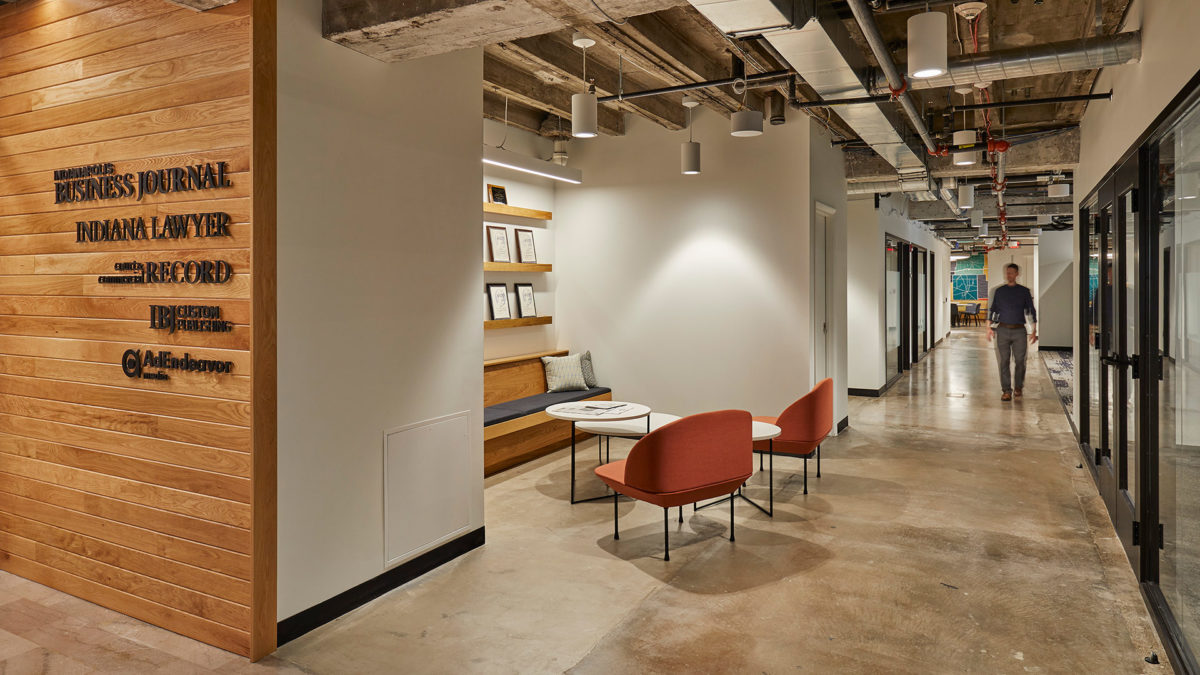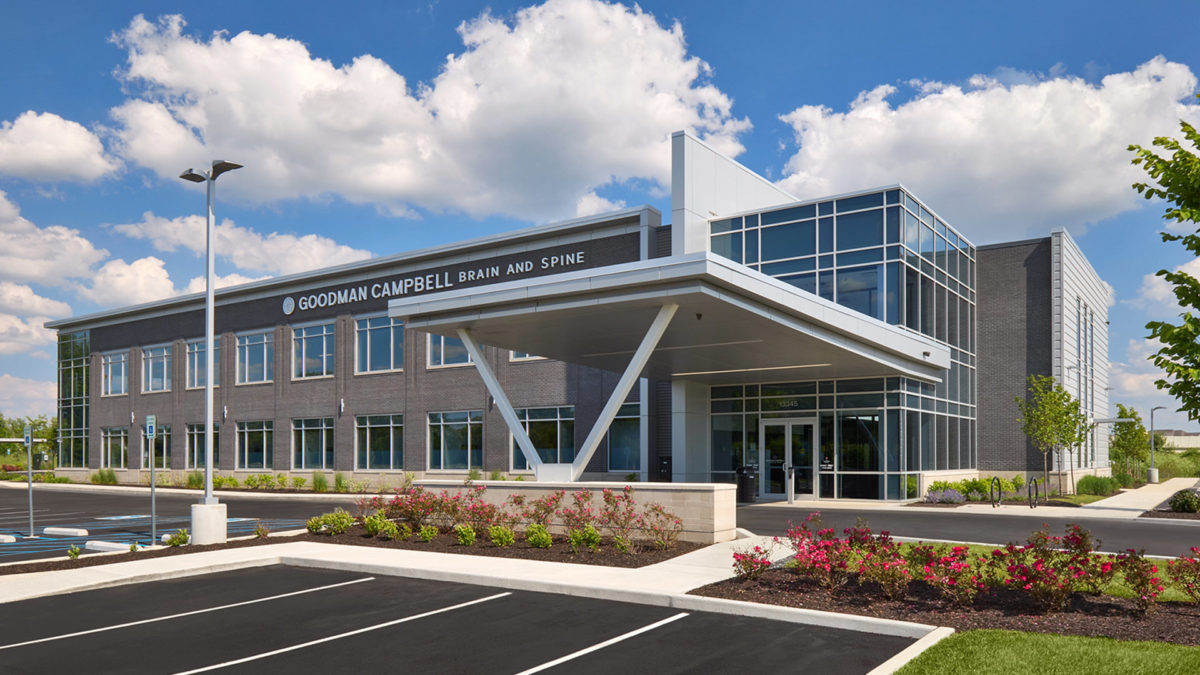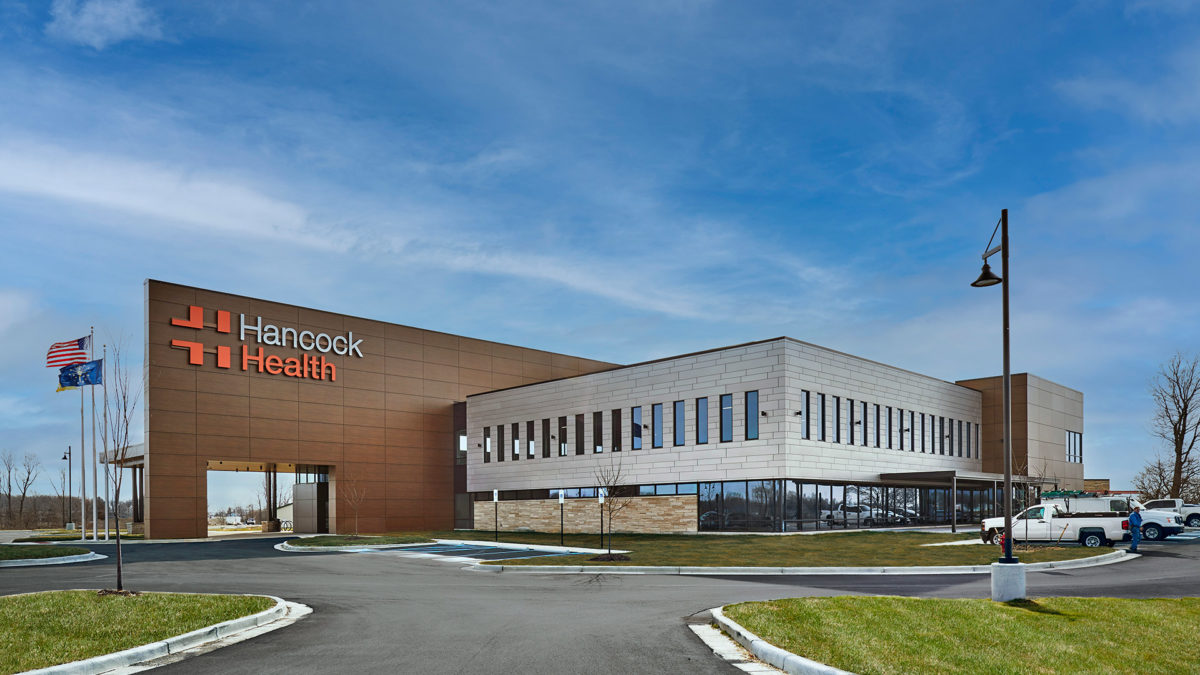
After nearly 40 years in the same office, IBJ Media had the opportunity to move to a historic building overlooking the iconic Monument Circle in downtown Indianapolis. CSO designed a space that features unique branding elements referencing the history of the printing industry while giving IBJ’s workplace a fresh new look.
Cursed with low ceilings and odd angles, the space presented challenges for space planning and capturing natural light. CSO’s interiors team focused on the positive – great views of Monument Circle and raw building materials that told the story of the building’s past. The designers embraced the odd building shape as an opportunity to carve out interesting spaces.
Upon entering the IBJ’s new offices, visitors are greeted by a custom art installation created from rolled up pieces of the IBJ’s past publications. Working closely with CSO, the artist took great care to highlight quirky references to Indiana, setting a sophisticated-but-fun tone from the very beginning. To the right, the reception desk sits in front of a black-on-black logo, representing raised printing press letters covered in black ink, a reference to the history of the profession.
Other creative decisions were guided by the mostly-linear layout of a newspaper and by the idea of the old meeting the new. As we sit at a crossroads between digital and printed news consumption, this new office tells a beautiful story of those things working in harmony with each other both in function and aesthetic.

Goodman Campbell Brain and Spine is a leading neurological healthcare provider. With a presence at major health institutions throughout the Indianapolis area, their newest office is their first stand-alone location. Seeing this as an opportunity to express their trusted brand through the use of space, they tapped long-time partner, CSO, for the job.
Upon entering the building, staff and clients are greeted with a 2-story dimensional wall and unique light sculpture, directly contrasting with an otherwise sleek and minimal lobby. It is immediately clear that this space is not a typical healthcare environment. Continuing into the first floor patient area, patients see a materiality not often associated with healthcare: diffused light art installations, clean white quartz, and black metal accents are paired with a textured carpet and wood accents to create a space that, despite its modernity, is warm and welcoming to all.
The exam area is laid out in an easy-to-navigate circular traffic pattern. As patients enter this area, they first see the checkout desk and its identifying feature: a stunning image of brain neurons which has been enlarged so much that the look could be mistaken for marble.
Upstairs, the reception area also sports a unique and beautiful installation. This time, a wood-and metal sculpture grabs your attention. It undulates against the wall, conjuring a spinal cord. Across the waiting room, patients can catch a glimpse of a companion piece: a spine-like light fixture hanging above a staff-only conference space.
Staff spaces are designed to the same standard as the patient-facing spaces. A social hub on each floor contains upscale casework and the warmth of a wood ceiling. The second floor social hub includes a dramatic upholstered bench. Both spaces provide respite from the staff’s naturally stressful jobs. Throughout, CSO’s interiors team focused on creating a space that felt curated and filled with art, similar to how staff and patients might curate their own art collections at home. By making a space that feels both forward-thinking and welcoming, CSO’s interiors team was able to express Goodman Campbell’s own approach to healthcare.

CSO conducted extensive visioning sessions with administrators, doctors, nurses, community members, and others in order to capture the spirit of Hancock Regional Health (HRH) and the people who would use this new campus.
Phase I of the project is the Gateway Clinic, which provides urgent care, imaging services, and a lab. The waiting area embraces updated concepts and offers café and lounge seating, encouraging patients to work or play while waiting for their appointments. The idea for this café-lounge waiting area became the backbone of the design and drove the architecture from the inside out. Working closely together, interior designers and architects were able to create a building that prioritized the needs of the community, patients, and employees without sacrificing efficiency or design aesthetic.
Another key component of the Phase I design was to plan for their anticipated growth. The second floor of the Gateway Clinic was left as shell space during the initial programming to accommodate future growth. As a follow-up to the initial planning, CSO worked with leadership to design and buildout the second floor just few years after they initially occupied the space.


